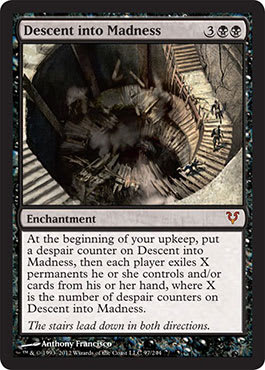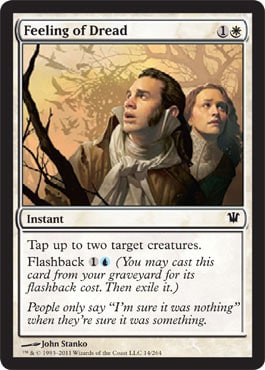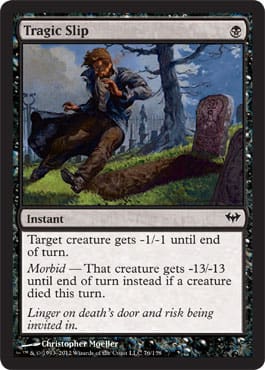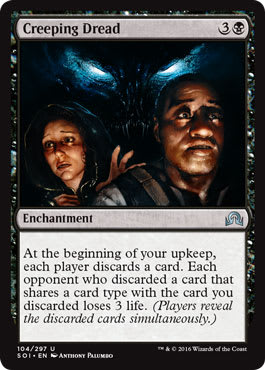The theme of Innistrad is not a plane, as evident as it may seem.
It’s not just Gothic Horror.
It is not defined visually as what it is, but rather, as what it isn’t.
In order to see it, you have to look past the main idea and see what lies beneath the surface. And yes, you do need to slow down to do so. This isn’t a Buzzfeed list. Walk, don’t run with me.
A whole day is dedicated to examining the fine details of a painting. #SlowArtDay, which just happened, urged you to take five to ten minutes. By doing so, you notice the details. Keep this in mind as you join me on a stroll through Innistrad
Let Us Stroll Carefully

Humble the Brute by Daarken
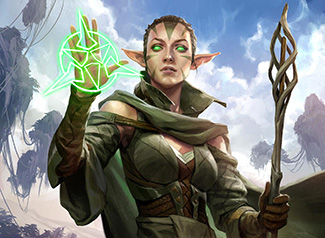 | 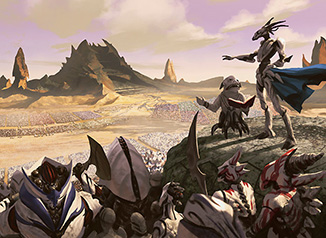 |
Oath of Nissa by Wesley Burt | War Report by Mike Bierek |
As we examine Innistrad by tearing away all the veneers of what we expect, we need to see what is not mentioned and what is not there as we pull back the blinds. Whereas both Zendikar and Mirrodin are in daylight and colorful, Innistrad is neither.
Innistrad had a visual code, and today, I’m here to help you crack it. Let’s find the themes by first what it isn’t.
Innistrad 1.0 was preceded by the first Return to block. Scars of Mirrodin was a world forged of steel, shininess, and a war with its outcome obvious. Scars was the science-fiction block, with Innistrad being the approachable, visitable fantasy. Even notes from an art director stated that Innistrad was to be “not Phyrexia” visually:
Innistrad 2.0 had Battle for Zendikar, another war set in a returned block in daylight. It wasn’t as much science-fiction as it was high fantasy with floating landscapes, impossible monsters, and heroes to save the multiverse. Zendikar’s return was an adventure world with big monsters and nearly anything possible. Innistrad was anything but. It has constraint, people walking on the ground, buildings having weight, and locations that are tangible. Check out my architecture review if you want to learn more about it. Zendikar was otherworldy to Innistrad’s gritty realism.

This mini visitation site was perfect for preview season. It gave what Vorthoses have wanted in maps without forcing designs to fit into the limitations of a map’s actual dimensions.
Steven Belledin, on the original Innistrad concept team, who took a full three weeks for himself and another week or two from others, was tasked to help shape a new world on these original parameters:
- The world was to have, among other things as inspiration, Eighteenth-Century Prussia.
- The world was almost constantly about 45 to 50 degrees Fahrenheit.
- The world was to be built entirely around horror tropes.
- These tropes included, but were not limited to, werewolves, vampires, mad scientists, zombies, Frankenstein's monsters, ghosts, devils, and demons.
- There was a religion having something to do with angels (this was still being fleshed out).
- This was the home world of the vampire Planeswalker Sorin Markov.

Innistrad concept art by Jung Park
Helping Steve were also Daarken and Steve Prescott to make this new world. After their push (with help from a few other artists), Jeremy Jarvis pushed them to have a “first-person camera” that made you feel that you were there—the dread and terror itself was coming in on you.
This “gag” has not really changed this go-around, and if anything, merely the antagonists have changed from vampires and such to angels. What has changed is the madness of the affected population and the visual focus. Innistrad is not just not dread anymore, but rather panic and paranoia.

Paranoid much? That’s a motte and bailey castle, the earliest type of fortification of cities.
Fortified Village by Cliff Childs
Cathars could fight back against vampires and things that go Bump in the Night. Now, humans stand utterly no chance against homicidal angels. In playing Dungeons & Dragons, you can build a castle strong enough to repel entire armies with siege engines, owlbears, and rust monsters. What is near impossible to defend against are small flying enemies and fire. Dragons run out of breath weapons, but angels can start fires from the very oil used to attack foes at the wall. When you combine multiple angels into an attack force, they are nearly an impossible foe for commoners. If we take our Vorthos to actual gameplay, if you can’t kill the Baneslayer Angel or Serra Angel quickly, you’re toast.

Johannes works digitally, but notice all the intentional brushwork in the flames above Avacyn’s wings. It’s a beautiful addition of texture to digital works, which can struggle with flatness.
Fiery Temper by Johannes Voss
The visual narrative of panic, paranoia, and hopelessness are not a thought—they’re real, and their angel savior will exterminate them. Art reflects this. Innistrad fear is real, and madness finds you when all you can do is wait for the inevitable. It makes sense that cult worship of a sea god, or any deity that will listen, is humanity’s only hope. Life is bleak when your faith doesn’t prevent tragedy. Quite.
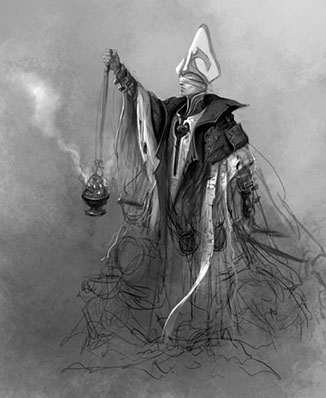 | 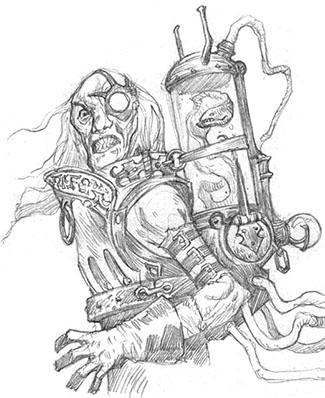 |
Concept art by Daarken and Steve Prescott. Note that their artists use both traditional and digital means to flesh out a set. Often, coloring happens later after themes and directions are chosen. I’ve been lucky to pick up a few pieces of concept art over the years. Let’s talk about that soon! | |
Depicting Madness, Losing the Will
Building on the visual theme of widespread paranoia and panic, early snippets from the Wizards communications team to news sources gave us strategic clues to follow that their intention was to depict madness. Showing mental illness is dangerous, as there is no right way to show sadness, shock, hopelessness, self-loathing, or simply nothing, among the myriad options. There are hundreds of ways to depict it incorrectly, and Magic chose to not have dozens of people with their faces in their hands, but rather used a high variety to show it. It’s subtle, and an early speculation season article on Ars Technica explains it further:
Magic let the mechanics depict the madness instead of showing it. That’s clever. It’s then reinforced with cards like Inquisitor's Ox hauling a guillotine.
This point is another of the visual narratives of the set. The conflict or story is both completed and unknown. The rising action of the angel Avacyn potentially being evil is here, but why she butchered her people is largely unknown. Likewise, as players aren’t Jace, we are not investigating the clues to learn why. We’re more akin to his partner, and yet, we are distracted in the investigation.
We are to play the game, and the flavor will ooze up toward us without us even knowing. True terror comes in when you know chaotic things occur for utterly no reason and there is nothing you can do. The mechanic delirium fits into this.
Look again at the artworks of Innistrad block 1.0, and see that things are incoming, or random happenstance. Now, it’s full paranoia because the threat and effects are real, and it’s only a matter of time before the angel or something unexplained takes them, whether it’s death or delirium itself. The only known factor is that it will.
This is a theme.
As we have the madness represented by mechanics, it allows more card arts to flesh out the world on the subplot of Nahiri being furious. Notice the five pivotal moments do not revolve around Nahiri yet. Declaration in Stone is an effect of her, but she is not the main focus. We are to attempt to understand why a mono-white Planeswalker had a character fracture, similar to Ajani Goldmane to Ajani Vengeant. Yes, she’s angry, but rash? Is Emrakul also affecting her? Why? The frenzied nature of Shadows over Innistrad forces our focus away and then back to her, adding to, “What’s going on?”
One thing largely missing from Innistrad this go-around is the singlehanded push back against the night. Images like Moment of Heroism or Spare from Evil are now rare. This is explained because their angel is no longer responding to their cries for help. Simply by showing what is missing from Innistrad, again, explaining the what-it-isn’t vs. what-it-is, shows us the lack of hope. It’s hard to push back the light when no one cares to help you. Dire indeed are humans when you realize their angel Avacyn is dead, and yet, we have an entire Eldritch Moon to see if the humans of Innistrad survive extinction.

Moment of Heroism by Christopher Moeller
Art Theme: Unraveling the Mystery
Visually, we are supposed to be investigating this set.
My advice is to look at the art slowly. Time yourself with fifteen seconds to look at every corner, and try to understand how the art directors are trying to hide in plain sight.
We see Jace finding clues and adding evidence together. Jace is our Sherlock Holmes, and we are more of a Watson, nodding at the findings. We’re tagging along on the mystery and actively encouraged by community-engagement efforts and the Hanweir Chronicle to participate. The art descriptions wax and wane between conceptual like Trail of Evidence and John Avon’s Clue token and scenes like the following:

Thraben Inspector by Matt Stewart
As the Eldrazi titan Emrakul left Zendikar and only affects living things, you have to scout to see what our inspector here has found. I’m assuming you already know that Emrakul is the reason Jace is on Innistrad, searching down help to both track down and make use of the Gatewatch to eliminate the final interplanar threat.
Matt Stewart just paints with utter ease, with comic book emotions such that our inspector here is both grossed out and dismissive of their unnatural growth in her city. Was that ivy or vines originally and then corrupted? It’s unclear, but it forces Vorthoses to search delicately for extra eyes on children, or mini-tentacles sprouting like a sixth finger. Even though we now still have a full list of cards in the set, there's still a lot about the story that we don't know and aren’t really sure when or how it will be explained. Will it be in the official story? The next set? Should we be asking for answers or will we just receive more questions?
As You Stare at Images, Looking for Clues, Keep These Main Storyline Questions in Mind
We are shown both Jace and Tamiyo searching for answers, reinforcing the Gatewatch theme of cooperation against major foes. If there is a side to be on, among the variety of protagonists in this set, science and reason are your allies, and discovering the unknown thing, probably terrible, is what I wish to both discover and defeat.

Catalog by Johannes Voss
Cosplayers have another depiction of Tamiyo up close, showing her stray hair that almost looks like sideburns. Fun!
 She’s being influenced to lose her mind and also to reflect a biblical story. In the Bible’s Book of Revelation 19:13, we might find an interesting allusion, stating, “And he was clothed with a vesture dipped in blood: and his name is called The Word of God.” Avacyn is a holy warrior, an embodiment of purity and also a destroyer. As such, she cannot ascertain anything other than her purpose, as it were. Taint her, and a holy avenger becomes an angel of death. Not lost on me are the four horsemen of the apocalypse, characters in this future-looking Biblical book. I recall seeing many of Albrecht Duerer’s woodcuts like The Four Horsemen of the Apocalypse shown here and seeing quiet depictions of future horrid visions. Hearing of trumpets and 1/3s of the world destroyed are hard for a reader to understand. Reading Descend upon the Sinful’s exiling of all creatures oddly makes more sense and hits home harder.
She’s being influenced to lose her mind and also to reflect a biblical story. In the Bible’s Book of Revelation 19:13, we might find an interesting allusion, stating, “And he was clothed with a vesture dipped in blood: and his name is called The Word of God.” Avacyn is a holy warrior, an embodiment of purity and also a destroyer. As such, she cannot ascertain anything other than her purpose, as it were. Taint her, and a holy avenger becomes an angel of death. Not lost on me are the four horsemen of the apocalypse, characters in this future-looking Biblical book. I recall seeing many of Albrecht Duerer’s woodcuts like The Four Horsemen of the Apocalypse shown here and seeing quiet depictions of future horrid visions. Hearing of trumpets and 1/3s of the world destroyed are hard for a reader to understand. Reading Descend upon the Sinful’s exiling of all creatures oddly makes more sense and hits home harder.
There are four angels on Innistrad and four angels in the Bible.
They are both tasked to remove the wickedness and those unfit for the revelation of the one true god. It appears less strange when that reveal is Emrakul and fights Ugin’s assumption that Eldrazi ingest planes at an equal rate that planes are created. Emrakul could visit planes, and by merely being in the vicinity, could affect entire religions, races, and families and disrupt everything. Only in this case, one angel was not corrupted, and we are to rest our hope in Sigarda.

Descend upon the Sinful by Tyler Jacobson
Moments in time, like photographs we take as Jace’s assistant, give us a glimpse of the theme of Innistrad. A plan is taking shape; we’re just along for the ride. I’m more looking at what the art is telling me than what the official Magic story is doing to connect the images to one another. I see Jace holding a book with an eerie, dead vampire hanging upside-down and frozen in time.
The longer I look at Chase Stone’s image here, the more I think of him as Lestat, watching Louis’s revenge against an entire family of vampires in Interview with a Vampire. I enjoy thinking of a cult-classic movie while playing my favorite contemporary game. Add in the standout composition of a blown-out wall with strong lighting on lifeless vampires, and we have a perfect storyboard image to show a passive of knowledge and growth in our understanding of Innistrad.

Tamiyo's Journal by Chase Stone
Yes, Emrakul is influencing Innistrad. The Tumblr Magic community has been logging instances of clues for weeks, and visually, it’s past the point of whether she has been on Innistrad and has now moved to a timeline of how long has she been there. Look at the sky. Even basic lands were given instructions to make a point that she’s there.

Swamp by Jonas De Ro
As a reminder, from the The Art of Magic: the Gathering: Zendikar book, “Trees and vines contort themselves into knobby, tentacle-like shapes. Animals and people, including survivors of battles where Emrakul was present, sometimes develop fleshy growths resembling the lattice structure of Emrakul’s body.”
We already know what to look for; Battle for Zendikar gave us an example of a humanoid turning into an Eldrazi. A ton of examples are apparent all over the place. Scan Reddit or Tumblr for ten seconds, and you’ll see oodles of examples. What I’d like to point out is that the first stage of corruption is already happening.
All we need to do next is turn the page on the set to see the middle stage of corruption. We know what will happen if Emrakul is not defeated—we have already seen it:

Incorrigible Youths Winona Nelson; Rush of Ice by Deruchenko Alexander

Westvale Cult Leader by David Palumbo
This set sure has some themes hidden under the surface, doesn’t it? We have the horsemen of the apocalypse, an unlikely savior, a creator destroying his avatar, and examination on the failure of religion to cult worship. Who better to show a cult than someone with a pedigree to do a simple scene right? You ask a Palumbo.
I love this composition, as it makes your eyes rise to the leader’s jawline. I’m looking to find why this cult exists and what icons they use to glean something for the faithless few who are turning to superstition for a life clutch. The more I look at this piece, the more I try to not look at her face. I can’t stop; I can’t prevent my eyes from moving upward. The lighting beckons me to stare at this charismatic leader’s face, exhibiting traits of her sea-god thing. It’s as if the cult leader’s painting was painted by an artist that understands how to assign power in a depiction. Great work by David.
That’s not to say the humans of Innistrad weren’t a bit peculiar before, having slightly crazed eyes. They did have cannibals in their ranks, after all. True to Palumbo’s form, he builds on an apparent style guide specification of having cult members hide their faces. Their leader is shown, mutated for some reason, giving us a clue or a red herring.

Village Cannibals by Bud Cook
Innovations in Art
If you’re new to reading my musings on art, you’ll see I no longer showcase the subjectively “best” artworks of the set. I’ll leave top-ten lists to the experts.
I’d rather showcase some nuance, some things that differ from the normal art descriptions and rules in sets. I find it more enjoyable, and you, the reader, gain some knowledge for your Friday Night Magic or to refer back to in the months to come. The signal is what should be highlighted, not the noise. The quality works will rise to the surface—they always do.
But as you look at the art yourself, beware of . . .
Red Herrings
As the main branded character is our investigator, Jace, we are living vicariously through his actions. In the time immediately after Oath of the Gatewatch, we were given about a week to discuss Conspiracy 2’s announcement, and then things immediately went into Shadows over Innistrad’s immersive previewing. We were to solve puzzles both in speculation season before the set and also threaded throughout the set.
It has become apparent through both the story the cards tell us and also through the official Magic story on what Nahiri did—which was to kill a lot of vampires and destroy Sorin’s home—and that an angel changed. Avacyn also became red in color. We see the what, but we don’t see the why. We can assume Emrakul is there due to the Innistrad art book, through visual precedent, and by ruling out other options. Though, the art directors aren’t making it easy. They’re giving us false clues and red herrings to examine.

Marit Lage token by Stephan Martiniere
The only other creature—or thing, really—that can travel between planes beside Planeswalkers and the Eldrazi titans is Marit Lage. Early in the speculation season—and especially as Engulf the Shore was previewed—I wasn’t convinced Marit Lage couldn’t be one of the options. It is a lovely shadow underwater with highly curved tentacles just like Marit Lage. It’s forcing us to think it’s possible, and I love it. With the entire set revealed, it’s nearly impossible now that our friend in ice matters to the storyline. That said, Emrakul can be underwater, and the Cliff Childs piece references both Marit Lage, old sea god, krakens, and our girl Emrakul. For cripes sake, they made two iterations to try to fool us.

Thing in the Ice by Svetlin Velinov
The ambiguity is only felt for a short amount of time, but playing the nuance between the two is art, story, and design all working in tandem to create diversions and excitement. I think it’s a minor art innovation, but a major future implication, as minor characters from the past could have more homages with Magic’s creators acknowledging fan favorites. I feel this is a precursor to Jaya being reprinted in some way shape or form. The gap isn’t farfetched now.

Engulf the Shore by Cliff Childs
Apparently, Garruk is causing corruption, too, says the community. Dozens of hands have quickly dismissed his corruption as involved via discoloration of the living material around him—that and he’s also cured, of sorts, of his affliction by Liliana. It does beg the question, though, of what he’s up to. As Liliana is on Innistrad for some apparent reason, so maybe Garruk could be there, too, but his curse isn’t involved. Liliana already killed Griselbrand, one of the four demons he bound herself to, making her involvement on Innistrad peculiar. She did ask Jace to help her kill her remaining two debts to demons, after all, mere months ago.
Just in case you think we are only on the #EmrakulConfirmed Train #GarrukIsAComin' #ChainVeilCorrupts pic.twitter.com/1XuEntlk9L
— Masters Of Modern (@theMMcast) March 24, 2016
The red herrings are unrelated, but I applaud the effort that people are looking at art and searching for clues. This leads us to the theme of reusing what’s old and changing the lens to make it new.
2. Returning Trope: Borrowing from Beloved Games

Elusive Tormentor and Insidious Mist by Anna Steinbauer
I know, animations do bother people who want to stare at artworks closely, but in this transformation, it’s utterly needed to show two things: digital painting is lovely when a change of time occurs, and there are always more tropes.
MJ Scott and I took nearly a month going over every card in Innistrad, over a series of six articles back in 2011, to talk art, tropes, cultural references, and more. I encourage you to look over it; it’s a product of its time, but we did document all the movie references we could find, which are many in the original Innistrad. An old colleague, Brendan Weiskotten, did one on Avacyn Restored as well.
What we have here is Anna Steinbauer giving us a before-and-after image using the same background, made different for the mechanic purpose of transformation. Ken Nagle mentioned how this design was based on Castlevania: Symphony of the Night. More on that game’s influence soon.

If you’ve never played the masterpiece that is SOTN, it’s worth borrowing from a friend to play on a Playstation 2. The music is incredible, the gameplay is tight, and its depth urged fans to spur creator Koji Igarashi to make a new “Igavania” side-scroller in Bloodstained: Ritual of the Night on Kickstarter. Not all tropes Magic uses as familiar territory is super-old!
3. Allusion Is Everywhere

Diregraf Colossus by Vincent Proce
This artwork was accepted into Spectrum 23, the art annual showcasing the best in fantasy and imaginative-realism art chosen by peers. Magic gets one to two dozen card artworks in each year, and this delightful body politic. That term is from Thomas Hobbes, a political philosopher, who wrote on why a monarchy is justified because a city or multitude of men could be united by one person for the common peace, defense, and benefit. (See Hobbes, Elements, Chapter 19, para 8.)
Not only is it an allusion to political science, Proce also has a nod and wink to Castlevania, probably from Nagle again. If you’ve forgotten where you’ve seen this before, check out the Granfaloon from Castlevania: Symphony of the Night boss stage, and enjoy the unbridled nostalgia. His sketches posted to his Facebook page show the hand, and it’s undeniable.
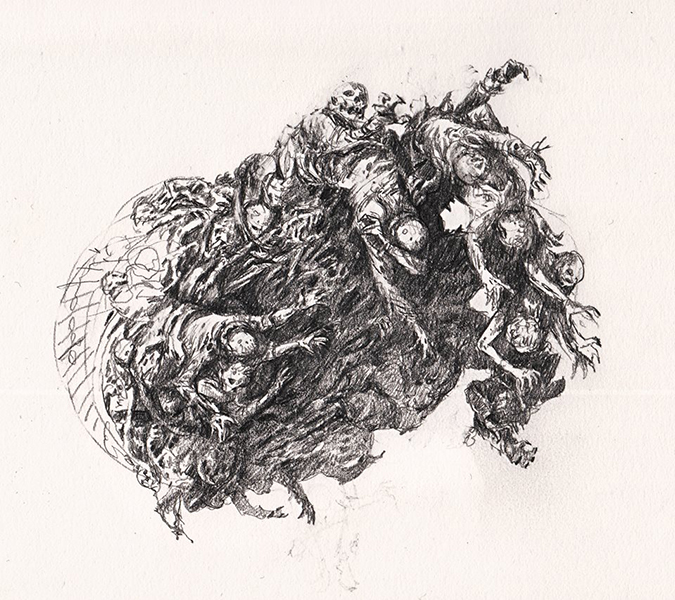
It’s just a beautiful concept made by a stellar creator. Hats off to you, Vincent; this is a home run!


Pale Rider of Trostad by Seb McKinnon
Article length remaining within reason limits me from discussing the merits of this pale horse and the thousands of depictions Seb builds upon in our contemporary culture. The card is a powerful Limited creature that punishes you immediately by forcing you to discard—to accept madness as payment for its services. It isn’t a creature to annihilate foes, but rather to wound the mind (your hand).
In multiples, this card stands out as a piece of art that doesn’t look like Magic. It’s a disruptive image that affects a large population of players. Whereas players may say the art is cool, taken from the perspective of an actual Planeswalker casting or bringing this creature, it creates a collective trauma. It’s meant to be harmful, yet beneficial. Players will see it’s drawback as a benefit, seeing this rider on the pale horse being a fine-art example in the set instead of what it’s actually alluding to: The rider atop the white horse from the book of Revelation in the Bible is death and destruction incarnate. Of the four horsemen of the apocalypse, only this rider and horse is named Death.
Seb painted the faceless rider as simplistic as possible, making this creature benign and accepted as a mere force in your carafe of spells instead of a destroyer of worlds.
I urge you to look stare at it and marvel that a digital artwork can, indeed, hold your attention and be a superb depiction complete with allusion and meaning beyond a commissioned assignment.

Death on the Pale Horse by Gustave Dore, 1865
4. Playfulness
There is a strong subtheme of bringing playfulness back in Shadows over Innistrad. Cards like Triskaidekaphobia and Trail of Evidence are bringing that 1990s sensibility of whimsy back into Magic. Showing a strongly conceptual and whimsical piece can have the necessary depth a 2016 set requires while having fun in doing so. It works both for new artworks and reprints like the preview card I received in Macabre Waltz by Will Murai.

Trail of Evidence by Daniel Ljunggren
Pushing the visual narrative to explain difficult events is done at the art-description stage and shows that the workshops the creative team have done in the past are bearing fruit in tandem with selecting from the expert tier of artists Magic can use. Magic has never had stronger artwork in a variety of styles, racial depictions, and mix of serious and fun to create a new normal of strong art that spans the sum of the set. With so much variety, it creates chaos that plays into Innistrad, but also gives options for every type of player and preference to find something that they enjoy!

Triskaidekaphobia by Will Murai
Wrapping Up
Innistrad dialed up Gothic Horror by a rejection of the science-fiction daylight of New Phyrexia, a world of metal and corruption. It then doubled down in realism to distance itself from the world of Zendikar, a fantastical world of gravity-rejecting landscapes. Innistrad is not a world of fantasy, it’s a world where religion is real and has turned on its loyal subjects. It’s an uncanny valley that may examine contemporary religion if you look closely enough and reveal much if you lend your opinion atop it. As it builds you a world that's familiar, you may find yourself injecting your beliefs on its culture.

Village Messenger by Daarken
As Eldritch Moon is the next set in our mini-block, we should expect a Lovecraftian influence more manifested. Though, worth noting is that H.P. Lovecraft’s writings aren’t about monsters and constant madness. That is often how the stories ended. What made them great was the buildup, the suspense, and the dread he built up in mere short stories. We were given the dread the previous time. We are now scared of everything, paranoid of everything from confined buildings and false idols to mere children.
-Mike
















